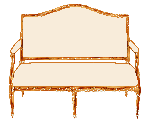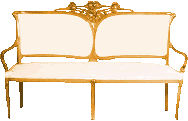|
|
SHORT HISTORY OF THE FRENCH STYLE SEAT
| LOUIS XIII
|




|
| It's in 1636 that the word armchair was used for the first time to name the "chaise à bras". With the rise of the midle-class, family life develops. The chaise à bras becomes "convenient for conversation" and it can be moved.Thanks to its sober form and decoration, it becomes more comfortable. The seat can be lowered and upholstered with fabric or embossed leather. |
| LOUIS XIV
|


 |
| The elaborate decoration of the Louis XIV style chaire makes it a pump chair reserved for the dignitaries... At the court as well as in the castle, the choice of seats follows closely the hierarchical order. For the princes: the armchairs, for the most titled lords: the chairs, for the courtiers: the stools, and for the "Dames d'atour" cushion laid on the floor... |
| REGENCE
|



 |
| Louis XIV's Reign strict etiquette wears off. The form soften, furniture legs are curved. To accomodate the "robes à panier", smaller armrest are used. Cane which was used since the first half of XVIIth century, had almost disappeared with the end of imports from the east india company.The restauration of trade links with Great Britain brings back the caning fashion appreciated for its lightness and resistance.
|
| LOUIS XV
|




|
| The fauteuil cabriolet appears arund 1740. It is the first armchair which backrest is curved to follow the back's form (in the fashion of the light car seat from which it derives its name). Curved, light and compact, it is comfortable and elegant. Maybe too comfortable for the learned members of the French Academy who find this chair indecent and unworthy of their Academy. |
| LOUIS XVI
|




|
| The neoclassical trend born under Louis XV takes its full extent in the Louis XVI style. Curves disappear while the straight line make a strong come back. If rigor predominates over form, it is adorned with ornaments of great variety. Tapestries are covered with flowers, rural and birds scenes... In 1776, a new armchair with a round seat and an oblong medallion backrest was created for the "comte d'Artois". This backrest form, will be very fashionable for the "à la reine" as well as for the "cabriolet" chairs. |
| DIRECTOIRE
|


 |
| In reaction with the preceding period, a certain discretion is to notice. One wanted an ideal republic on the Roman model. Flowers of Lily were replaced by symbols such that the lance, consular beams, the phrygian cap, the eye of the reason in the middle of a triangle, the rosette, the rhombus, etc... Trades with distant countries being difficult carpenters use local wood which they wax or paint. Thus painted woods imitates the bronze. The curule chair born under the precedent reign becomes usual |
| EMPIRE
|


|
| With the return of the Egyptian expedition, Egyptian motifs will develop. They adorn rectangular, geometric line chairs with a balanced and solemn shape. Chiseled bronze makes then shine. Mahogany is the favorite wood until 1806, date of the blockade ordered by Napoleon 1st which closes the continent to british trade. Imports of mahogany wood into France cease, it is replaced by indigenous wood which are sometimes stained in the "mahogany fashion". |
| RESTAURATION
|


 |
| With the return of the Bourbons on the French throne, lily flowers substitute for eagles and others Empire emblems...The form soften and marquetry is back. Contrary to dark mahogany, fashion is for whitewood adorned with purple heart and rosewood volutes... Known since Louis XV and distinguished by its enveloping backrest, the fauteuil "en gondole" will have a great success. Of small dimension, simple, light and elegant it will remain fashionable untill 1840. |
| NAPOLEON III
|


 |
| Ever in all preceding centuries one invented and manufactures so much seats. Second half of 19em century was to this title the period of the seat by excellence. Also to each forms of back will be adapted a sofa, sometimes a "chauffeuse", a deckchair or a "duchess". Confidants and the indiscreet are creations of the second Empire. We feels in the profusion of the Tapestry an English influence (the victorian century).Design of flowers in round bouquet, to basket, in garland are the main decorative elements on the tapestries. Nevertheless colonies bring their part in oriental motives (asian especially). preceding style copies are growing and experts of today can again be confused. |
| ART NOUVEAU OR MODERN STYLE
|




|
| Moderne Style: (1895-1925) To the dawn of the XXth century, with the industrial advent of that era, the style of life change and progress is fast. International Fairs of the end of the last century promotes the exchanges, thus an international style appears under the name of Art nouveau, Modern style, Jugendstil, Art and kraft, Liberty. The main topics of the Modern Style are from vegetable inpiration. By predilection this period will use forms in "knock of whip", the sinuous shapes of the lianas, the bindweed or the water lilies. These undulating movement do a reverence to the flexibility and suppleness of female hair. One distinguishes two treatments of this vegetable proliferation. To one side these sinuous lines are insulated and drawn as in filigree, leaving great parts of the background visibles. Another treatment to the opposite although also using these same sinuous forms will fill up all surface of the tapestry in an inextricable intermix. Colors alone making the part of the contrast and thus facilitating the reading of the pattern. In France it is to Nancy that grown this brilliant breath that brought up all the modern decoration. According to Emile Gall�, glassmaker master and decorator of furniture: "the exemple has to be taken on the vivid to the museum of the nature." . . . . "Each artist has to see in all spring as its clean resurection." |
| ART DECO
|




|
| Art Deco: (1914 to 1930) The industrialization of the production of the furniture does not allow the tapestry of seat to adapt to all the creative profusion. Nevertheless for the comfortable armchair of steamships, as well for the luxurious hotel, and of course, that the individuals rich home, and so "bourgeoise one, great artists like Raoul Dufy will create drawings for textiles and will leave there wonderfull composition. The Negro art is on the weave and one will find a lot inspiration in the decoration of cloths and the tapestry of seat. Three periods can be distinguished in the Art Deco's style : A period of revival (1910-1923), an other that we can name "Floral" (1919-1931), a last finally characterized by the modernism and the geometrical form (1923-1936). |
|
|




































